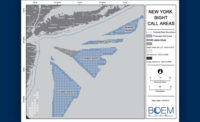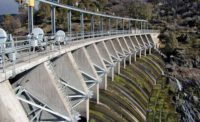Regional power transmission providers in the US would have to extend planning over a 20-year horizon to identify building needs based on developing changes in generation and demand—under a proposed Federal Energy Regulatory Commission rule the agency approved April 21 to gain feedback for the country's needed grid infrastructure upgrade and expansion to accommodate new and cleaner energy sources.
Last year, $15 billion in transmission projects entered into service, according to a FERC market report. In a post-meeting statement, newly-named Commissioner Willie Phillips said some 1,300 GW of solar, wind and energy storage capacity awaited interconnection as of last December. The PJM Interconnection system, which serves all or parts of 13 eastern and midwest states, has some 250 GW of power projects backlogged for connection and announced a recent major change in its approval process.
Current transmission infrastructure “is not being built fast enough to support the energy transition,” said one industry observer. The FERC proposal could remedy that, he said, but noted it will take a decade or two to see the full effect.
Bipartisan Vote
Agency Commissioner Allison Clements termed FERC's 4-1 bipartisan vote “a really important first step to address the nation’s pressing need for forward looking transmission infrastructure investment.”
FERC seeks feedback on transmission planning, cost allocation among states and power connection policies. Proposal comments are due 75 days after publication in the Federal Register. FERC has not confirmed the publication date.
Factors that grid operators will need to incorporate into infrastructure decisions include new state and local renewable energy targets, fuel costs, retirement of older generation, extreme weather, cyber security risks and changing technology.
The latter includes approaches such as dynamic line ratings and power flow converters that can add capacity to existing systems, possibly reducing need for more expensive new construction, FERC staffers said at the meeting. The goal is to maximize benefits to customers without overbuilding transmission, they said.
Inter-regional power delivery potential is a key emerging issue, particularly for east coast offshore wind energy projects that now are being designed to include "meshed" or "backbone" transmission infrastructure.
In his statement, Phillips acknowledged the proposal did not address changes in existing interregional transmission coordination rules, which remains on FERC's reform agenda. "Looking beyond regional boundaries is important so that cost-efficient regional and interregional projects can be considered and studied together," he said, adding that FERC also needs to consider requirements "for a minimum amount of interregional transfer capacity to protect against generation shortfalls."
To further address reform concerns, FERC will hold an Oct. 6 technical conference on transmission management and cost allocation.
“It’s a big deal, a near landmark rulemaking and will have significant ramifications to the industry,” said Kent Herzog, a senior managing director at design-build firm Burns & McDonnell. The proposal is set to generate fundamental change in how the transmission grid is planned for, built and paid for, he said.
Noting the bipartisan vote for the proposed transmission revamp rule, Kevin Ludwig, grid solutions leader at engineering firm Black & Veatch, expects FERC would finalize it by year end.
More State Input Up Front
FERC Chairman Richard Glick, a Biden Administration appointee to the role, noted one key proposed change that would “give states an additional role for cost allocation” in planning long-term regional transmission projects. Commissioner Mark Christie, a former Republican state regulator in Virginia, said the proposal would put states at the heart of planning for such projects for the first time.
“It’s an opportunity for state regulators to protect consumers,” he said. Clements said the rule would not “foist the costs of one state’s policies onto another.”
Regina Davis, a spokeswoman for the National Association of State Utility Commissioners, praised FERC for "acknowledging the necessary role of state regulators inherent in electric transmission planning.”
But Commissioner James Danly, a Trump administration appointee and former FERC general counsel who was the sole dissenter, said that while the proposed rule is the result of a compromise, it steers transition to certain types of generation resources by "putting public policy choices ... front and center in the transmission planning process."
Clements, a Democrat also named to FERC by Trump, countered that the proposal “is not a policy action to promote renewable energy.” She said its call for “smart planning ... will allow grid planners to satisfy system needs and navigate the twin risks of building too much or too little.”
Doubled Capacity Seen
Ludwig emphasized that reliance on the grid will rise dramatically as electrification increases. “We will see additional build in the transmission space,” he said, noting studies indicating need for between 60% and 100% more capacity than currently in place.
The proposal is an important step in recognizing changes in the generation mix, said Phil Moeller, executive vice president of the Edison Electric Institute, which represents investor-owned utilities.
But Paul Patterson, an electric industry analyst at Glenrock Associates, is somewhat skeptical that the proposed rule would have its intended effect. “It’s too early to say how this will turn out,” he told ENR. “History has taught us that transmission changes don’t usually turn out the way they were expected.”





Post a comment to this article
Report Abusive Comment